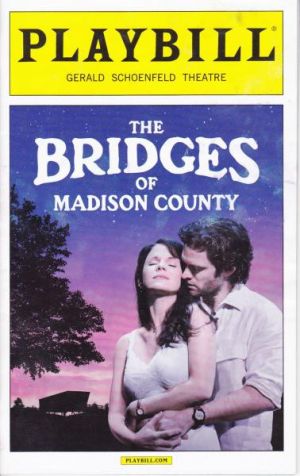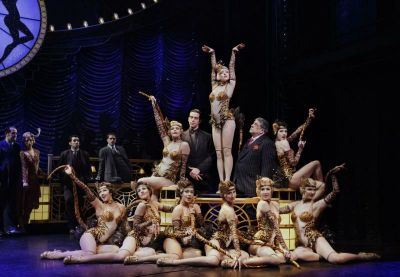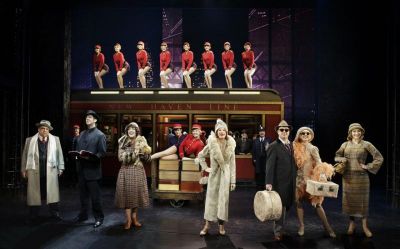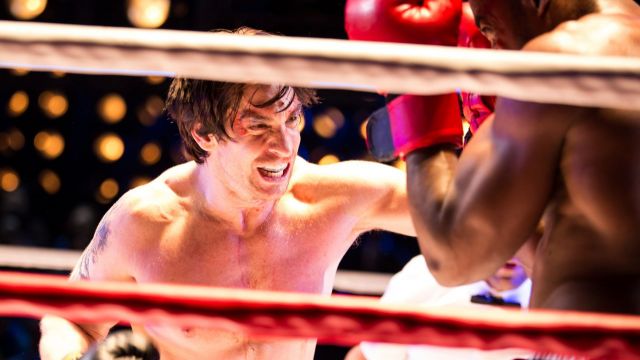BROADWAY’S CINEMATIC TREATS
Has Hollywood become the out-of-town try-out for stage musicals? Screen to stage adaptations certainly dominated the Great White Way when Stage Whispers’ reviewer Peter Pinne spent a week in New York in May catching up on some of Broadway’s newest musicals.
Back when talkies started in the early 1930s Hollywood plundered Broadway for stories and stars. Today it’s the reverse. Broadway continually digs deep into the Hollywood vaults. A season doesn’t go by without several screen-to-stage adaptations. Every musical I saw on Broadway this year was based on a movie.
On paper, Rocky, the 1976 Sylvester Stallone Oscar-winning film, seemed an unlikely subject for a musical, but the show that sat on the Wintergarden stage was a five-star knockout. A perfect cast headed by Andy Karl and Margo Seibert, inventive direction by Alex Timbers, and brilliant choreography by Stephen Hoggitt and Kelly Devine, especially the fight sequences, made it one of the most thrilling experiences I’ve had in a theatre in recent times. Not only was it a triumphant spectacle and exciting on every level, it was also a musical with heart. You cared for the characters.
 Working from Stallone’s original screenplay, Thomas Meehan and Stallone had retained the movie’s well-known plot about Rocky Balboa, a working-class Philadelphia boxer and sometime thug who gets a shot at the big-time and wins the bout and his girl Adrian. They also kept most of the movie’s iconic moments including Rocky slurping raw eggs and his pounding hind-quarters of beef at the Shamrock Meat freezer. It was all there in a script that was spare but effective.
Working from Stallone’s original screenplay, Thomas Meehan and Stallone had retained the movie’s well-known plot about Rocky Balboa, a working-class Philadelphia boxer and sometime thug who gets a shot at the big-time and wins the bout and his girl Adrian. They also kept most of the movie’s iconic moments including Rocky slurping raw eggs and his pounding hind-quarters of beef at the Shamrock Meat freezer. It was all there in a script that was spare but effective.
In the title role, Andy Karl was appealing, sexy, buffed, vulnerable, and a guy you wanted to root for. Margo Siebert brought warmth to the mousey and shy Adrian, and together their on-stage chemistry was potent. Terence Archie as Apollo Creed preened and strutted like a reigning champ, Dakin Mathews’ gym-owner Mickey was solid, while Danny Mastrogiorgio made a convincing but odious Paulie whose character had been softened somewhat from the film version.

But while Karl and Siebert carried the emotion of the plot, it was Stephen Hoggett’s fight choreography that was the star. From the moment we saw Rocky and his boxing buddies training in the gym, to the final title bout, Hoggitt’s choreography took us through every sweaty blow, move, and punch with exquisite agony. You smelled the testosterone and the adrenaline rush was exhilarating.
$4.3 million was spent on Christopher Barreco’s industrial-scaled set and you saw every dollar of it up on stage. Floating panels, elevated catwalks, and a full-sized boxing ring that at one time became vertical and at the finale moved out into the auditorium and sat over the first seven rows of seats (the audience who had been sitting there had been moved up on stage to sit on bleachers behind the ring to watch the action). The intimate scenes were restricted to Rocky’s one bedroom apartment which he shared with his two turtles Cuff and Link, the pet store where Adrian worked, and the locker room at the gym.

Christopher Akerlind’s striking lighting design worked overtime along with Dan Scully and Pablo N. Molina’s stunning video projections which moved the plot along throughout the show. There was an especially memorable pre-dawn running sequence which took the ‘Italian Stallion’ and a bunch of guys in grey sweats and hoodees through city streets, along the Schuylkill River and up the grand steps of the Philadelphia Museum of Art. It was riveting.
Bill Conti’s iconic Rocky theme song “Gonna Fly Now” and “Eye of the Tiger” from the third Rocky movie had been added to Lynn Ahrens and Stephen Flaherty’s original score which was a far cry from their previous work on Once On This Island and Ragtime. Flaherty, who grew up in the 70s, captured a sound of the period but also retained his original musical voice. Particularly good was Rocky’s first character-building solo “My Nose Ain’t Broken”, the ballads “Happiness” and “Raining”, and the waltz at the ice-skating rink, “The Flip Side”, The score has been heavily criticised but I thought it was right for the characters. The piano and guitar sound with an occasional string overlay worked for the poignant and intimate spots with the brass and thumping bass building the excitement in the bigger moments.
 Andy Karl played the title role when the musical was workshopped in New York in 2011, before it had its out-of-town tryout (sans Karl) in Hamburg, Germany on 18 November 2012 where it is still playing. The entire Broadway creative team worked on the Hamburg production, which also included Terence Archie as Apollo Creed. He’s the only actor to have appeared in both productions.
Andy Karl played the title role when the musical was workshopped in New York in 2011, before it had its out-of-town tryout (sans Karl) in Hamburg, Germany on 18 November 2012 where it is still playing. The entire Broadway creative team worked on the Hamburg production, which also included Terence Archie as Apollo Creed. He’s the only actor to have appeared in both productions.
But despite good notices a long Broadway run eluded Rocky which closed August 17th due mainly to the fact that musicals about sport are a notoriously hard sell to theatregoers.
Rocky images by Matthew Murphy.
**
If Rocky was the most spectacular new musical on Broadway then A Gentleman’s Guide To Love and Murder was the funniest. In development since 2006 it had two regional productions before opening at the Walter Kerr Theatre 17 November 2013. The critics loved it but audiences were hard to come by in its first few months. Now, thanks to a Best Musical Tony its fortunes have turned around.
 The show was based on Roy Horniman’s 1907 novel Israel Rank, which later became a 1949 black and white British film called Kind Hearts and Coronets starring Alec Guinness. Set in Edwardian London in 1909, the plot had a penniless heir to the D’Ysquith family fortune bumping-off all who stood in his way to inherit it. The body count was as high as that other grisly killer Sweeney Todd, but this murderer was much more fun.
The show was based on Roy Horniman’s 1907 novel Israel Rank, which later became a 1949 black and white British film called Kind Hearts and Coronets starring Alec Guinness. Set in Edwardian London in 1909, the plot had a penniless heir to the D’Ysquith family fortune bumping-off all who stood in his way to inherit it. The body count was as high as that other grisly killer Sweeney Todd, but this murderer was much more fun.
Robert L. Freedman wrote the book, Steven Lutvak the music, and together they created the lyrics. Newcomers to Broadway, the pair had written a musical that was fresh, funny, and musically ripe with melody in the style of 19th-century operetta and Gilbert and Sullivan with flashes of Noel Coward wit.
As the penniless heir Monty Navarro, Bryce Pinkham was one of the musical stage’s most endearing murderers. You could not help but love him and root for him at every turn as he bumped off eight of his relatives. Playing all of the eight mostly pompous relatives (male and female), was the multi-talented Jefferson Mays. He skipped, danced, ice-skated, and bicycled through these various roles with astonishing ability and changed costume in the blink of an eye. It was a dazzling performance.
But it was not the only dazzling performance in this gem of a show. Lisa O’Hare as the socially ambitious Sibella, looked demurely attractive, had a delightfully delicate poise, and sang in a glorious clear soprano, whilst Lauren Worsham as Phoebe, Monty’s other love interest who decides to marry him, was delicious. Their second act trio with Pinkham “I’ve Decided To Marry You” was simply hilarious.

The set, by Alexander Dodge, was a recreation of an English Music Hall with a detailed stage within a stage on which most of the action happened. Linda Cho’s period appropriate costumes added to the fun which was directed skillfully by Shakespearean specialist Darko Tresnjak who had been part of the project since the beginning.
Orchestrator Jonathan Tunick, who orchestrates all of Stephen Sondheim’s musicals, also added a musical gag of his own by including a few of the opening orchestral bars from “Attend the Tale of Sweeney Todd” at the beginning of “Stop! Wait! What!” when Monty was arrested. It was an in-joke but it was amusing. There is a long life ahead for A Gentleman’s Guide To Love and Murder especially in regional and community theatre.
A Gentleman's Guide to Love and Murder photographs by Joan Marcus
**
If Rocky was the most spectacular, and Gentleman’s Guide the funniest, then Aladdin without a doubt was the most magical. Disney’s latest animation-to-stage adaptation was one giddy magic carpet ride of riches. Casey Nicholaw pulled every trick out of his choreographer/director’s hat and came up with an Arabian Nights extravaganza that was chock full of colourful effects, retro vaudeville schtick, and more baubles, bangles and beads than a bazaar in Baghdad.
 The plot, set in the Arabian town of Agrabah, concerned the Sultan’s daughter Jasmine (Courtney Reed), who is tired of being locked up behind palace walls and runs away to the Bazaar where she meets street rat Aladdin (Adam Jacobs) and is immediately smitten. The sub-plot has the nefarious Jafar (Jonathan Freeman), who has eyes on becoming Sultan, convincing Aladdin to steal the magic lamp which contains a Genie so that his wish may come true. But like all good fairytale plans things go awry when Aladdin becomes master of the Genie.
The plot, set in the Arabian town of Agrabah, concerned the Sultan’s daughter Jasmine (Courtney Reed), who is tired of being locked up behind palace walls and runs away to the Bazaar where she meets street rat Aladdin (Adam Jacobs) and is immediately smitten. The sub-plot has the nefarious Jafar (Jonathan Freeman), who has eyes on becoming Sultan, convincing Aladdin to steal the magic lamp which contains a Genie so that his wish may come true. But like all good fairytale plans things go awry when Aladdin becomes master of the Genie.
Chad Beguelin’s book cleverly switched Aladdin’s monkey sidekick in the movie to three singing and dancing vagrants, Babkak, Omar and Kassim, and made the lamp’s Genie a human. The latter was a gift of a role which James Monroe Iglehart grabbed by the throat and delivered with sass. A big African-American performer, he sang, danced, did somersaults, and commanded the stage whenever he appeared. His big first act number “Friend Like Me”, done in a glittering and sparkling Aladdin’s cave, referenced pop-culture with Igelhart singing X Factor style Menken’s previous Disney hits, “Beauty and the Beast” and “Part of my World”. The sequence also included references to TV game shows and their like, and built to an unbelievably rousing finish. It literally stopped the show and got a standing ovation. I’ve never before seen a number stop the show in the middle of an act and receive a standing ovation. It was amazing!
 But more magic was to come in the second act when Aladdin and Jasmine sang “A Whole New World” flying around the stage on a magic carpet and you did not see any wires. It was awe-inspiring and one of the best effects I have ever seen on stage.
But more magic was to come in the second act when Aladdin and Jasmine sang “A Whole New World” flying around the stage on a magic carpet and you did not see any wires. It was awe-inspiring and one of the best effects I have ever seen on stage.
Adam Jacobs was a spunky and totally winning hero with six-pack abs, while Courtney Reed was a pretty but also spunky heroine. Jonathan Freeman, who voiced the role of Jafar in the movie, made a meal of the part on stage. His big number “Diamond In the Rough,” a tango, had him channelling Cyril Richard’s Captain Hook in Peter Pan.
There’s no doubt Aladdin has a long-life ahead of it. It’s one of the most enjoyable musicals in the Disney franchise.
Aladdin images by Deen Van Meer
**
The Bridges of Madison County was a popular 1992 best-selling novel by Robert James Waller before it became a successful 1995 movie with Meryl Streep and Clint Eastwood. Waller’s story, set in Iowa in 1965, saw a rural housewife having a ‘Brief Encounter’ affair with a National Geographic photographer while her husband and kids were away for four days at the Indiana State Fair.
In the musical version director Bartlett Sher had cast the main characters of Francesca and Robert younger, and made the neighbours and townspeople of the community part of the whole fabric of the piece. One of them was always on stage as an observer of the love affair taking place. It was an interesting directorial device that worked for the plot.
 It’s undoubtedly the best score Jason Robert Brown has ever written for the theatre which was endorsed by Tony voters giving him their Best Score award. Using mainly acoustic guitars and strings as his accompaniment, he has composed various long-soaring melodic lines for the ballads, of which there are many, and leavened it by the occasional touch of country and blues.
It’s undoubtedly the best score Jason Robert Brown has ever written for the theatre which was endorsed by Tony voters giving him their Best Score award. Using mainly acoustic guitars and strings as his accompaniment, he has composed various long-soaring melodic lines for the ballads, of which there are many, and leavened it by the occasional touch of country and blues.
The songs were tailor-made for star Kelli O’Hara and she rose to the occasion giving one of her most tender and touching performances as a woman torn between the conflict of settling for something safe and secure or something that ignited her passions (for a moment). The opening “To Build a Home” which she sang with the company was stirring and lovely. She also has some standout solos with “Almost Real” registering strongly.
Steven Pasquale as Robert was the perfect match for O’Hara as an actor and vocally delivered a performance that was warm and sincere. He also had several solos, but his baritone was shown to thrilling effect on his final “It All Fades Away”. Both performers were paired together in last year’s Off-Broadway Far From Heaven, and they brought the same intensity and emotion to Bridges.
Hunter Foster was also especially good bringing a nice laconic touch to Francesca’s husband Bud, while Cass Morgan and Michael X. Martin were amusing as gossipy neighbours Marge and Charlie. Morgan’s “Get Closer” performed as a radio rock ‘n’ roll standard provided some unexpected humour.
Marsha Norman’s book intelligently covered the back stories: Francesca as a young survivor of World War II in war-torn Naples marrying American serviceman Bud and returning to rural Iowa to work a farm and raise two children, and Robert’s marriage to a young spacey folksinger which didn’t work out. It helped delineate who the characters were but it made for a very, very long show, too long for a love story as fragile as this.
Bartlett Sher’s direction had the actors continually moving the scenery (fences, kitchen, bedroom etc) on and off the stage which helped give the show a strong sense of community. There was little choreography, but Danny Mefford’s movement was appropriate, especially during the hoedown in the State Fair sequence.
I caught the third last performance of Bridges which opened 20 February 2014 and closed in May. It failed to find an audience and played to just over fifty per-cent capacity for the last month. I liked it but found the emotion lacking. Towards the end of the show I momentarily had a lump in my throat, but I did not cry and I felt I should have. Itwas an art-house musical with high production values, good music, and a superb cast. The fact that it could not find an audience was no reflection of the show which is sure to have an afterlife.
**
 If ever a movie had ‘Potential Broadway Musical’ stamped all over it, it was Woody Allen’s Bullets over Broadway. The 1994 film set in the 1920s about an idealistic young playwright who gets a chance at Broadway with a cast that includes a gangster’s moll and an alcoholic leading lady, seemed to be an ideal property for musicalization. But although director and choreographer Susan Stoman’s work was nothing short of miraculous in its invention, the show just did not fizz like it ought to. When it ended you had to ask yourself if songs added anything to the story and the answer was no. More fun would be had by renting the movie and watching it again.
If ever a movie had ‘Potential Broadway Musical’ stamped all over it, it was Woody Allen’s Bullets over Broadway. The 1994 film set in the 1920s about an idealistic young playwright who gets a chance at Broadway with a cast that includes a gangster’s moll and an alcoholic leading lady, seemed to be an ideal property for musicalization. But although director and choreographer Susan Stoman’s work was nothing short of miraculous in its invention, the show just did not fizz like it ought to. When it ended you had to ask yourself if songs added anything to the story and the answer was no. More fun would be had by renting the movie and watching it again.
Part of the problem was Woody Allen who wrote the book based on his and Douglas McGrath’s screenplay, and his determination to use existing songs from the 1920’s. Apart from Cole Porter’s “Let’s Misbehave”, and Hoagy Carmichael’s Up a Lazy River”, which were heard as background in the movie, and Richard Whiting’s “She’s Funny That Way”, the rest were mainly obscure and have had no afterlife since they were first written. After a while they all tended to sound the same. Musically the show was caught in a 32-bar chorus strait-jacket and no amount of inventive orchestration or arrangement could free it. Also, the placement of the songs within the plot, was tenuous at best. An original score would have solved everything.
 But Stroman’s work was wonderfully entertaining even if we were admiring style over substance. Sexy chorines strutted their stuff as train porters, black-hatted gangsters tapped their hearts out, and vulgarity raised its head with “The Hot Dog Song”. It was frothy; it was flashy; it was old-fashioned musical comedy.
But Stroman’s work was wonderfully entertaining even if we were admiring style over substance. Sexy chorines strutted their stuff as train porters, black-hatted gangsters tapped their hearts out, and vulgarity raised its head with “The Hot Dog Song”. It was frothy; it was flashy; it was old-fashioned musical comedy.
Best performance came from Nick Cordero as Cheech, the gangster who discovered his hidden playwriting talent. Tall and gangly, his dry delivery totally captured the fun of the character. Brooks Ashmanskas was a funny Warner Purcell, the actor who cannot keep his hands away from the buffet table, Karen Ziemba went for goofy as Eden Brent, the actress with the mutt, and Helen Yorke managed to mangle her dialogue perfectly as Olive Neal, the bimbo with theatrical ambition.
Zach Braff (Scrubs) worked hard and mugged shamelessly as playwright David Shayne but had little chemistry with Marin Mazzie who was ferociously unsubtle as the alcoholic diva Helen Sinclair, the role that won Diane Weist an Oscar in the movie.
Bullets Over Broadway photos by Paul Kolnik.
**
The last show I saw was Kinky Boots, and thanks to Harvey Fierstein’s book, one of the best film-to-stage adaptations currently on Broadway. It’s been playing a year now and has had a couple of cast changes with Andy Kelso replacing Stark Sands as Charlie Price, and Jeanna De Waal taking over the Lauren role formerly played by Annaleigh Ashford. The good news however was Billy Porter was still around to continue his award-winning performance as the drag-queen Lola.
 The musical, based on the 2005 movie which starred Joel Edgerton (Charlie) and Chiwetel Ejiofor (Lola) (last year’s Oscar-winner for 12 Years a Slave), was another battler-fighting-against-the-odds-and-winning story. Fortunately Fierstein has retained the British midlands setting of the original and except for the odd word here and there the adaptation was flawless. Accents were straight out of Coronation Street.
The musical, based on the 2005 movie which starred Joel Edgerton (Charlie) and Chiwetel Ejiofor (Lola) (last year’s Oscar-winner for 12 Years a Slave), was another battler-fighting-against-the-odds-and-winning story. Fortunately Fierstein has retained the British midlands setting of the original and except for the odd word here and there the adaptation was flawless. Accents were straight out of Coronation Street.
Kelso was appealing and gauche as Charlie who inherited a losing shoe factory when his father died but hit upon the inspired idea to make boots for the niche drag-queen market, with Porter helping him achieve the impossible, winning over the anti factory-hand Don and starring on the Milan catwalk. Jeanna De Waal was delightfully kooky as Lauren, the factory worker who has designs on her boss, while Cortney Wolfson wore Lauren’s stilettos with style.
Adding Lola’s drag-queen ensemble to the chorus numbers was an idea that paid off royally. They were the piquant spice in the sauce.
Cindy Lauper’s score, last year’s Tony winner for Best Score, could not be better. From the rousing opening number “The Most Beautiful Thing in the World”, through to the high-octane insistent beat of the finale “Raise You Up” and “Just Be”, the songs hit their target every time. Porter delivered his eleven-o’clock number, “Hold Me In Your Heart” in true Whitney Housten diva style, while “Not My Father’s Son”, a duet for Charlie and Lola, was emotionally rewarding. It is one of the best songs that’s ever been written about sons who do not follow in their father’s footsteps.
Masterful direction and choreography by Jerry Mitchell continually elevated this show to something more than wonderful. It gave loads of pleasure, excited, and brought tears of joy at the finale.
**
If all film-to-stage adaptations could be as good as Kinky Boots, Rocky, Gentleman’s Guide to Love and Murder and Aladdin, then I hope Broadway continues to raid the Hollywood vaults for years. This season’s cinematic treats could not have been better!
Subscribe to our E-Newsletter, buy our latest print edition or find a Performing Arts book at Book Nook.

